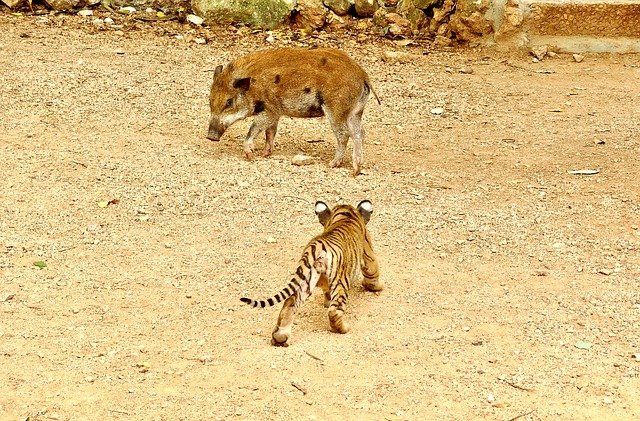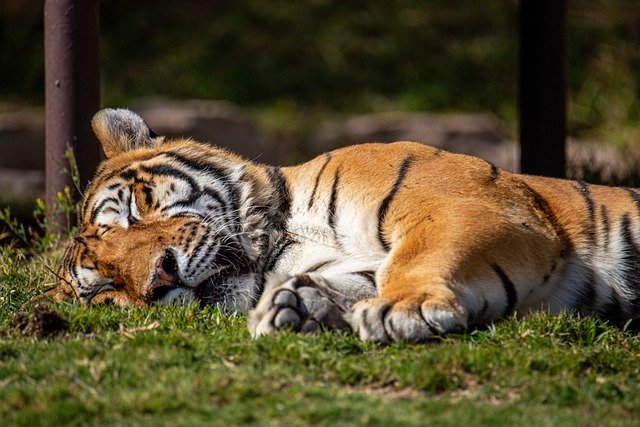As an Amazon Associate I earn from qualifying purchases.
In the hidden tapestry of the lush Indian wilderness, a relentless pursuit of survival unfolds every day as Bengal tigers, the undisputed royalty of the jungle, chart their path through life’s intricate mosaic. At the heart of this fierce dance of nature lies a question that has long intrigued scholars and wildlife enthusiasts: What do Bengal tigers eat?
As we step into the intriguing world of these magnificent apex predators, we’ll unravel the secrets of their gastronomic preferences, one prey at a time, and discover their vital role in maintaining the delicate balance of their wild kingdom. Join us on this thrilling journey through the gastronomic wilderness of Bengal tigers, where every meal is a masterpiece and every hunt an epic adventure.
What Do Bengal Tigers Eat?
The Bengal tiger, a majestic and powerful big cat, is an iconic symbol of the Indian subcontinent’s rich biodiversity. Known for their striking appearance and incredible strength, Bengal tigers are apex predators with a diverse diet that plays a crucial role in maintaining the balance of their ecosystems. In this blog post, we will explore the dietary preferences of Bengal tigers in detail, shedding light on the various foods they consume to survive in the wild.
1. Deer
Deer, such as spotted deer (chital) and sambar deer, are primary prey for Bengal tigers. These large herbivores provide a substantial source of nutrition for the tigers due to their size and abundance in tiger habitats. Tigers are known for their stealth and agility when hunting deer, which they typically ambush and bring down with a single, powerful pounce.
2. Wild Boar
Wild boars are another important part of a Bengal tiger’s diet. These omnivores are found in forests and grasslands and are relatively easy prey for tigers. Tigers employ their strong jaws and sharp teeth to make quick work of wild boars, often consuming them in a single meal.
3. Gaur (Indian Bison)
Gaur, also known as Indian bison, is the largest wild cattle species in the world. Although they are formidable animals, Bengal tigers are known to take down gaur occasionally, showcasing their immense strength and predatory prowess. These large prey provide tigers with an abundant source of meat.
5. Nilgai (Blue Bull)
The nilgai, or blue bull, is a common prey species for Bengal tigers in their range. Nilgai are herbivorous antelopes that often serve as a readily available food source for tigers. Tigers use their stealth and ambush techniques to hunt nilgai successfully.
6. Wild Buffalo
In some regions, Bengal tigers also target wild water buffalo, particularly when other prey species are scarce. These massive animals are challenging to bring down, but tigers rely on their strength and cunning to secure a meal.
7. Small Mammals and Birds
While larger prey forms the bulk of their diet, Bengal tigers are opportunistic predators and may consume smaller mammals like hares, monkeys, and birds. These smaller animals provide a variety of nutrients and are often hunted when larger prey is scarce.
8. Fish
Tigers are known for their swimming abilities and occasionally hunt fish, particularly in regions where water bodies are abundant. They often wade into the water to catch fish with their powerful jaws and sharp teeth.
How Do Bengal Tigers Hunt Their Prey?
Bengal tigers are renowned for their exceptional hunting skills, which have evolved over millions of years to make them one of the most effective apex predators in the world. Their hunting strategy is a fascinating blend of stealth, strength, agility, and patience. Here’s a detailed look at how Bengal tigers hunt their prey:
1. Stalking and Observation:
Tigers begin their hunt by patiently stalking their prey from a distance. They use their excellent vision, acute hearing, and well-developed sense of smell to detect potential targets. Their striking coat, adorned with dark vertical stripes, helps them blend seamlessly into the tall grasses and shadows of the jungle, making them nearly invisible to unsuspecting prey.
2. Approach and Stealth:
Once a target is identified, the tiger goes into stealth mode, moving silently and meticulously towards its prey. Their padded paws make minimal noise, allowing them to get close without alerting their quarry. Their low posture and slow, deliberate movements help them stay hidden until the opportune moment arrives.
3. Ambush and Pounce:
Tigers are ambush predators, relying on surprise for a successful kill. They explode from their concealed position and pounce on their prey with remarkable speed and precision when they’re within striking distance. Their powerful hind legs propel them forward, often covering a distance of up to 10 meters (30 feet) in a single leap.
4. Throat or Neck Bite:
To ensure a quick and humane kill, Bengal tigers typically target the throat or neck of their prey. They use their massive jaws and sharp teeth to deliver a powerful bite that severs the spinal cord or causes suffocation by collapsing the windpipe. This method ensures that the prey is incapacitated swiftly and minimizes the risk of injury to the tiger.
5. Drag and Conceal:
After the successful kill, Bengal tigers often drag their prey to a secluded location to enjoy their meal in relative safety. This behavior is an instinctual response to avoid potential scavengers or predators that might steal their hard-earned meal.
6. Feeding:
Tigers can consume a significant portion of their kill in a single meal, devouring up to 40 kilograms (88 pounds) of meat in one sitting. They start by consuming the soft and nutritious organs, such as the liver and heart, before moving on to the muscle tissue. Tigers are strong enough to break bones to access the marrow, ensuring no part of the prey goes to waste.
7. Recovery and Rest:
After a hearty meal, Bengal tigers often rest and digest for several hours or even days. They need this downtime to recover their energy, especially if they’ve expended much during the hunt. During this period, they may also lick themselves clean to remove traces of blood and scent, reducing the risk of detection by potential rivals or scavengers.
8. Hunting Frequency:
Tigers are not always successful in their hunts, and their success rate varies depending on factors like the terrain, prey availability, and hunting skills. On average, they may hunt every 5 to 7 days, which can fluctuate significantly.
How Can Bengal Tigers Impact Our Environment?
Bengal tigers, as apex predators, have a profound impact on their environment, exerting significant ecological influence in the regions they inhabit. Their presence and behaviors play a crucial role in maintaining the balance of their ecosystems. Here’s a detailed look at how Bengal tigers can impact their environment:
1. Control of Prey Populations:
Bengal tigers are at the top of the food chain in their ecosystems, preying on various herbivores such as deer, wild boar, and gaur. By controlling the populations of these herbivores, tigers help prevent overgrazing and habitat degradation, which can occur when herbivore numbers are left unchecked. This, in turn, benefits the health of the forests and grasslands.
2. Diverse Prey Selection:
Tigers are opportunistic hunters and may switch between different prey species depending on availability. This behavior prevents any one herbivore species from becoming excessively abundant, promoting biodiversity in the ecosystem. It also ensures that tigers do not exhaust the populations of any particular prey species.
3. Carcass Scavengers:
After a tiger has finished a meal, scavengers such as vultures, hyenas, and jackals often feed on the remains of the carcass. This scavenging behavior contributes to the efficient recycling of nutrients within the ecosystem. It also benefits other wildlife species that may not be direct competitors of the tiger for prey.
4. Habitat Management:
Tigers are territorial animals, and their presence can help regulate the movement of other predators and herbivores within their territory. This territorial behavior can indirectly influence the distribution and abundance of various species, contributing to a healthier and more balanced ecosystem.
5. Seed Dispersal:
Tigers play a role in seed dispersal as they move through their territories. They may carry plant seeds in their fur, which can be deposited across their range. This helps in the regeneration of plant species and contributes to the overall health of the forest.
6. Tourism and Conservation:
The charismatic nature of Bengal tigers attracts ecotourism, which can bring economic benefits to local communities and governments. These financial incentives often drive conservation efforts to protect tiger habitats and combat poaching, indirectly benefiting a wide range of species within the ecosystem.
7. Indication of Ecosystem Health:
The presence of a thriving Bengal tiger population is often an indicator of a healthy ecosystem. Their decline or disappearance can signal underlying issues such as habitat degradation, declining prey populations, or human disturbances that need to be addressed for the overall well-being of the environment.
8. Cultural and Spiritual Significance:
Bengal tigers hold cultural and spiritual significance in many societies. Their presence can contribute to cultural identity and traditions, fostering a connection to the natural world. This can, in turn, lead to increased efforts to protect their habitats and conserve biodiversity.
Final Words
In conclusion, the hunting prowess of Bengal tigers, showcased in their stealthy stalking, precise ambushes, and powerful bites, is a testament to their status as apex predators. Through this intricate dance of predator and prey, they answer the age-old question: What do Bengal tigers eat? Their dietary habits, deeply intertwined with their role in maintaining ecological balance, contribute to the health and diversity of their ecosystems. As we marvel at their hunting techniques and appreciate their importance in the wild, it becomes clear that the Bengal tiger’s survival is not just a matter of curiosity but a critical concern for preserving our planet’s natural wonders.
You can also read:
1.What Do Venus Flytraps Eat? A Detailed Guide to Their Carnivorous Diet
2.What Do Silverback Gorillas Eat? The Diet of Silverback Gorillas
3.What Do Painted Lady Butterflies Eat? From Caterpillar to Butterfly
4.A Lovebird’s Culinary Delight: What Do Lovebirds Eat?
Amazon and the Amazon logo are trademarks of Amazon.com, Inc, or its affiliates.



